Phiture, headquartered in Berlin, is a multi-award-winning mobile growth consultancy working with the teams behind leading apps. Using the company’s industry-acclaimed Mobile Growth Stack as a strategic framework, the Phiture team offers four key services: App Store Optimization, Apple Search Ads, User Retention services and Growth Consulting.
Read on to learn their three key reasons behind a lack of cohesion between email and mobile channels, and how to integrate them.
Mobile is now a crucial medium for consumers to interact with brands. A recent survey showed that we check our phone more than 50 times a day, if not constantly. For marketers, it’s easy to look at this data and understand just how important mobile channels are for reaching your users.
But what about other channels?
Although mobile channels are very effective and have their advantages, email continues to be a steady foundation for all marketers. Consider the following, for instance: according to a 2014 McKinsey & Co study, email marketing is still 40 times more effective at reaching your target consumer than Twitter or Facebook.
Combined with the fact that over 60% of the emails are also now opened on mobile devices, creating a seamless cross-channel experience is a top priority for marketers.
But marketers working with both avenues often lack the right cross-channel integration. One thing we’ve noticed at Phiture is that there’s a huge gap between email and mobile campaigns.
Effectively, they’re out of sync: Many companies struggle with siloed teams working in separate worlds, using real-time user data to inform their email content and strategy.
Instead of cross-channel integration, we tend to see multi-channel disintegration.
In lieu of treating these as separate channels, companies should think about the cross-channel interaction with their users, establishing a relationship between them that is seamless and targets the user in the right way.
This article focuses on some of the key strategies we would recommend to teams and companies facing this disjunction between channels.
The Parallel Universe of Email and Mobile
A comprehensive study by Iterable, which studied 30 apps across five verticals, showed that despite users already having downloaded the app, almost a quarter of companies (23%) included a “download the app” prompt in their email campaigns, and only 20% of companies had a cart or browse abandonment campaign.


HelloFresh’s new customer email promotes an already-installed app.
Consider the following example from HelloFresh. It’s a confirmation email from an order placed with the app. The company promotes downloading the app in the bottom part of the email—yet it’s obvious that any user receiving this email already has the app installed.
The bottom part of the email is valuable space to either upsell add-ons or re-route the user to another channel. Instead, it’s a blank spot on the canvas.
The same example also illustrates lack of data syncing. The default app language should be in English; the email, however, is in German. Moreover, the email is asking the user to review recipes that they have already reviewed previously in English.
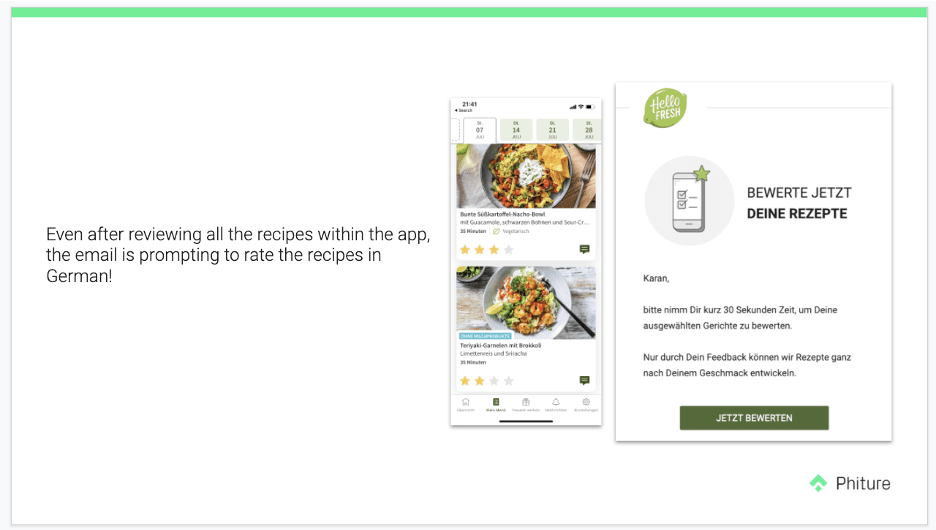

Keep track of user behavior across channels to ensure proper personalization, including language.
The disjunction is clear: Email doesn’t know what’s going on in the mobile ecosystem; they’re effectively working in two different worlds where both channels are not synced properly. It’s also a waste of a touchpoint.
We’re not here to single out any particular brand, because this email is just one example of how companies are currently struggling to make sure that email and other channels work in a harmonious and cohesive manner for the customer.
But what are the main causes behind the lack of cohesion between the channels? At Phiture, we’ve identified three key reasons:
- Brands have robust email and mobile programs, but the teams are siloed. At its core, many teams face organizational issues between mobile teams and email teams. Email teams don’t know the mobile onboarding series; mobile teams don’t know the email series. There’s a lack of cross-functionality, and both tend to work independently of one another.
- Brands that don’t necessarily have siloed teams often have data accessibility issues. It’s a question of data integration: If you can’t pass the data on, then it makes it way harder to have teams in sync. Many teams do not have the right processes in place to share a single source of truth of the data, making it virtually impossible to create a seamless cross-channel experience.
- Brands that are new to either mobile or email as a channel leave one of the channels underutilized and thus leave a lot of untapped value on the table. Many app-based companies have huge mobile teams, and very small email teams. This organizational structure is particularly evident in companies that are mobile-first, and haven’t explored email as a legitimate channel. As illustrated in the next section with the Burner use case, it’s a question of real estate.
The Real Estate Debate
Another common challenge for mobile-first companies is the lack of real estate with mobile channels.
Consider the example of Burner, a privacy app that does not need you to create an account to use the service. The app prompts users to give their email address so that they can learn more about how to get the most out of the product.
In the case of Burner, educating users is crucial for them to acclimate to the app and its functionality.
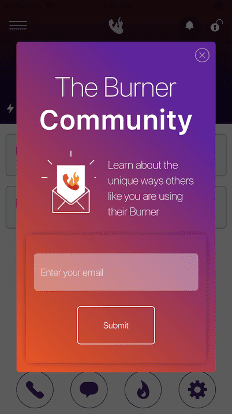

Burner’s in-app message prompts users to enter their email addresses to join the community.
Push notifications don’t offer enough space to fully educate users, despite offering more real estate than in the past with images and interactivity.
The same goes for in-app messages, which could disrupt the user flow when not triggered at the right moment.
Cue email: It works as a great channel resource, with more space for offers and multiple CTAs.
The case of Burner illustrates a mobile-first app that is now using email to inform and educate customers on its essential features that increase retention and engagement.
If you’re a mobile app that hasn’t quite integrated email as a prime channel, there’s always time to create the right infrastructure in place to facilitate cross-channel campaigns.
The question is how.
How to Integrate Both Channels
Lack of cross-channel integration may seem like one of those big issues from both a managerial/optimization perspective. So, too, does allotting the right real estate between both channels.
But for companies dealing with siloed teams, there are a few simple steps that companies can take to integrate both email and mobile to create a seamless user experience.
1. Begin at square one
Map out customer journeys with both mobile and email teams, and understand the top three to five key user actions that both teams would benefit from.
Touchpoints are crucial here: Having a great onboarding flow, for instance, is absolutely essential, and should be a combination of pushes as well as emails that trigger both user actions and “aha” moments.
Take a look at the graphic below.
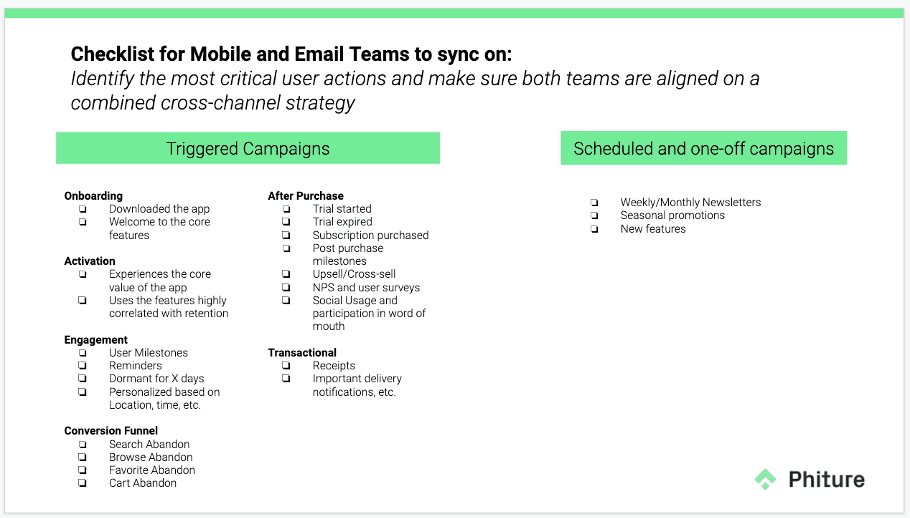

A checklist like this aligns email and mobile teams. (Source: Phiture)
2. Data as a single source of truth
Make sure to have documentation of your taxonomy for CRM platforms so that both teams understand what are some of the user information that can be used in their campaigns (see graphic below).
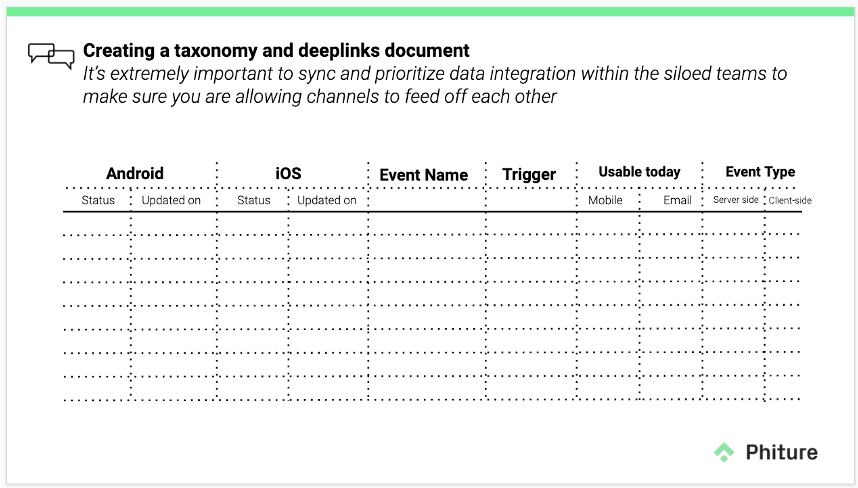

A template like this keeps events and triggers organized. (Source: Phiture)
The same goes for any other important source of data worth sharing between both teams. The more you can share between both teams, the better.
3. The regular sync
One of the most crucial elements is to simply sync both teams through communication.
A regular sync on projects and performance is easy to implement: Depending on team sizes, a quarterly or monthly meeting is a great start to increase alignment (see graphic below).
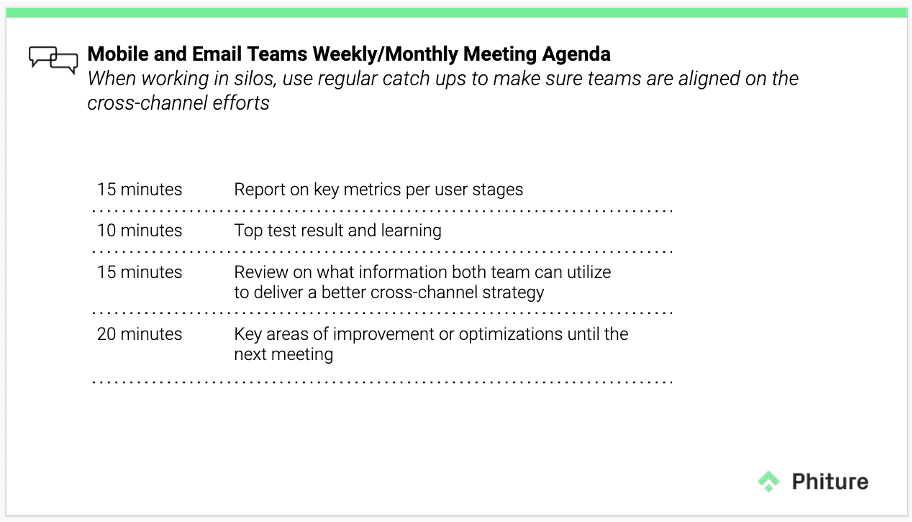

Keep all teams on track with detailed agendas for each meeting (Source: Phiture).
It’s important to make sure that regular syncs lead to key, common action points that both email and mobile teams can work on concomitantly.
Key Takeaways:
- Companies often work with email or mobile first, and instead of cross-channel integration, you see multi-channel disintegration.
- As a result, there’s a huge gap between email and mobile. They’re not in sync; there are no touchpoints.
- Brands are often siloed in terms of organization, don’t have the right shared data channels, and often emphasize one channel over the other.
- Real estate is important, too. Understanding how emails can amplify and optimize a campaign can also lead to increased metrics. This is especially true for mobile-first apps.
- Instead of treating email and mobile as separate channels, companies should think about the cross-channel interaction with their users. They should establish a relationship between them that is seamless and targets the user in the right way.
- Integrating cross-functionality through regular syncs, data taxonomy, and shared goals can avoid silos and help create a seamless cross-channel experience.
We at Phiture work with a lot of clients across different verticals, to assist and deliver such seamless experiences. Want to learn more? Check out what we do and our success stories with some of our clients.
































